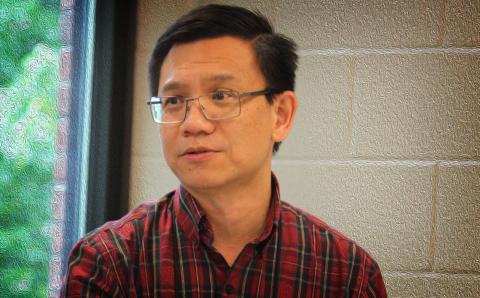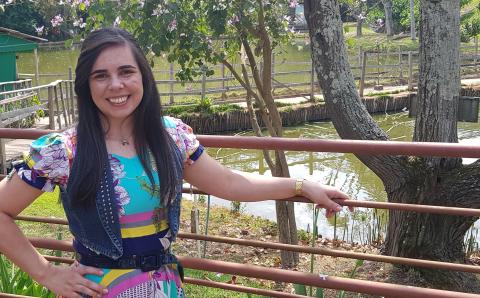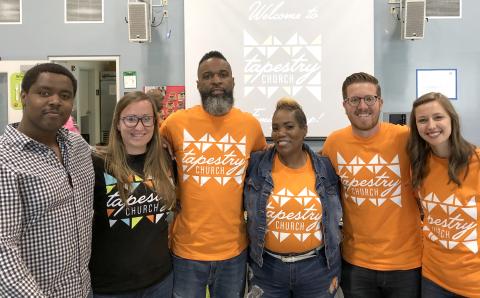At Madison Square Church, she’s known as Miss Mary or, to some, Mother Mary, because Mary Cancler is a true matriarch of the church she has been a member of for almost 50 years.
Born Mary Bingham on Aug. 8, 1927, in Muncie, Ind., Mary was raised from the age of 4 in a little Kentucky town called Cadiz, population 500—but only with “counting the chickens and the hens.” (Besides Mary, Cadiz’s other luminary is “Yakety Sax” saxophonist Boots Randolph.)
Mary was 8 when her baby sister, Deloris, was born, one of 11 children born to the Binghams, a family with roots in Europe, Africa, and Indigenous tribes of North America. Deloris Traylor also attended Madison for decades, but before the sisters would move to Grand Rapids and begin attending a Christian Reformed church, there was growing up to do in the Jim Crow South. There was also an unjust history with which to reckon.
Mary’s family tree includes one great-grandfather, a Native American, who was bought as a slave in Texas and brought to Cadiz with whip scars on his back. “That’s how we ended up in Kentucky,” Mary said. Her white grandfather, a man for whom her Black grandmother worked, never knew his son—Mary’s father—who could “pass for white.”
“My father was never bitter,” Mary said. “He was a good, loving Christian man.”
The Bingham girls and their siblings attended a segregated school to which they were transported daily in the back of a pickup truck, rain or shine, 20 miles each way. They attended a Black Baptist church, and she was baptized at the age of 12 “out in a river” after “going down to the mourning bench.” In the Black Baptist church of the South, when you turned 12 years old you were expected to “go down” to a bench or seat at the front of the church, set apart for sinners seeking salvation, as a sign that you were repentant and you wanted to be baptized and join the church. When Mary was taken to the river to be baptized, her younger sister Laura was “hollering and crying,” Mary said. “She thought they were going to drown me.”
In 1954, teenage Deloris got caught in the updraft of the Great Migration, the relocation of more than 6 million African Americans from the rural South to the cities of the North, Midwest, and West from 1916 to 1970. “Driven from their homes by unsatisfactory economic opportunities and harsh segregationist laws,” History.com says, “many Blacks headed north, where they took advantage of the need for industrial workers.”
Deloris had plenty to do in Grand Rapids, where she quickly found work in a factory that manufactured body mounts for GM, Ford, and Mercedes, and painted car parts. According to Mary, who was left behind in Cadiz, Deloris had “money in her pocket and nice clothes and a nice suitcase” when she came back for a visit. Sometimes when Deloris called her on the phone, she jingled her money into the receiver so Mary could hear it.
Mary, lured by Deloris’ success, moved to Grand Rapids herself a few years later. She found work at Blodgett Hospital, and she met and married Lee Cancler, an electrician at General Motors. They would be married for more than 40 years before his death.
By the 1960s, the couple had five children: Jacqueline, Lee Coy, Rodney, Bruce, and Marsha. They moved to Prospect Street in the Madison Heights neighborhood, home of Madison Square CRC. At the time, Mary was attending True Life Baptist Church, the church she had attended since moving to Grand Rapids with her brother’s girlfriend.
The church came across the sisters’ radar when a pastor’s wife named Martheen Griffioen began tutoring one of Deloris’ sons at Iroquois School on the southeast side of Grand Rapids. Griffioen’s husband was the interim pastor at Madison, and she invited Deloris and her family to come be a part of it.
By this time Deloris had seven boys and one girl. A woman named Hilda Auckman picked up her children every Sunday morning and drove them to church and Sunday school. Mary’s children also began attending youth programs there.
In 1973 the sisters attended a special Mother’s Day program at the church. Mary was impressed with the quality of the program and how well her children sang. “The Bible says ‘a little child shall lead them,’” Mary said. She and Deloris began attending the almost all-white church and have stayed ever since.
When Mary first came to Madison, there were just a few other Black families. Still, she felt at home there instantly. “I just loved it,” she said. “It was ‘come as you are.’” The congregation quickly became “a home church for me.” (Lee Cancler, Mary’s husband, attended a Methodist church.)
It wasn’t just that her children enjoyed the kids’ programs. Mary was drawn to a couple of facets of life at Madison.
One draw was the weekly reciting of the Apostles’ Creed.
“I believe in God, the Father almighty, creator of heaven and earth … .” That’s the beginning of the code and canon Mary heard that first Sunday morning at Madison. It filled her then and now with substance, a sense of belonging, and an identity whose roots ran deeper than race, gender, geography, or economics. “The best thing about that is, you know who you are” after listening to the creed, she said.
She knew who she was in Christ, and also in the body. “Back in those days, we knew everyone in church,” Mary said. “Pastor Vern Geurkink used to visit me all the time. He was a real sweet man.”
Since the onset of the COVID-19 pandemic the sanctuary at Madison has been quiet save for the occasional recording of a pastor preaching a sermon to an empty room. Mary watches the sermons on her phone from home and continues to pray “every day for the leaders and the pastors of the body of Christ.” She prays for her fellow church members, and awaits the day when she can safely worship with them again.
Mary also prays daily for the homeless and takes twice-weekly drives into downtown Grand Rapids with her daughter to see firsthand how the vulnerable people she prays for are faring. “‘Lord, open a door for them,’ I pray,” she said.
Mary has belonged to Madison for 47 of its 106 years, and she hopes her offspring will continue to grow at church and make it their core and foundation until they are all together enjoying “the life everlasting.”
“One day I prayed that my children would be going here until they are in the grave,” Mary said with a laugh. “But then I realized that wasn’t right. They just needed to go to a Bible-believing church.
“But you know what?” She can’t help but smirk a little. “They are still all here!”
About the Author
Lorilee Craker, a native of Winnipeg, Man., lives in Grand Rapids, Mich. The author of 16 books, she is the Mixed Media editor of The Banner. Her latest book is called Eat Like a Heroine: Nourish and Flourish With Bookish Stars From Anne of Green Gables to Zora Neale Hurston.








